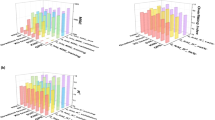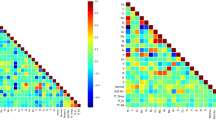Abstract
Heritage data for the class of 9 to 12 wt pct Cr steels are studied using data science to quantify the statistically significant relationships among multiple processing/microstructure and performance variables. The effort is undertaken to find new martensitic steels for creep life of \(10^5{{\text { hours}}}\) or greater at 650 °C and 100 MPa using machine learning. Linear regression and lasso regression were utilized to identify alloying elements that contribute towards better creep strength. Visualization techniques such as t-distributed stochastic neighbor embedding and pair-wire element specific comparisons were utilized to explore information gaps that exist within the data and are in conflict with existing domain knowledge. Combining all results suggest that the next alloy design to be explored should be 9 wt pct Cr with high W (2 to 3 wt pct) and high Co (2 to 3 wt pct) for creep life of \(10^5\,\,{\text { hours}}\) or greater at 650 °C, 100 MPa.









Similar content being viewed by others
References
U.S. Energy Information Administration: What is U.S. electricity generation by energy source? U.S. Energy Information Administration (EIA) Apr 2017.
J. Shingledecker, R. Purgert, and P. Rawls: in Proceeding the 7th International Conference on Advances in Materials Technology for Fossil Power Plants, 2013, pp. 41--52.
R. Viswanathan and J. Nutting: in Advanced Heat Resistant Steels for Power Generation: Conference Proceedings, 27--29 April 1998, San Sebastian, Spain: IOM Communications, 1999.
F. Abe: J. Pressure Vessel Technol. 2016, 138 (4), 040804
V.K. Sikka: in Topical Conference on Ferritic Alloys for Use in Nuclear Energy Technologies, J.W. Davis and D.L. Michel, eds., Snowbird, UT, June 1983, pp. 19--23.
F. Abe, S. Nakazawa: MTA 1992, 23(11), 3025--3034.
K. Yamada, M. Igarashi, S. Muneki, F. Abe: ISIJ Int. 2003, 43(9), 1438--1443.
T. Horiuchi, M. Igarashi, F. Abe: ISIJ Int. 2002, 42(Suppl), S67--S71.
Materials Genome Initiative for Global Competitiveness: Tech. rep. Jun. 2011.
S.M. Arnold, F. Holland, T.P. Gabb, M. Nathal, and T.T. Wong: The Coming ICME Data Tsunami and What Can be Done, American Institute of Aeronautics and Astronautics, 2013.
S.M. Arnold, F. Holland, and B.A. Bednarcyk: Robust Informatics Infrastructure Required for ICME: Combining Virtual and Experimental Data, American Institute of Aeronautics and Astronautics, 2014.
K. Rajan: Informatics for Materials Science and Engineering Data-Driven Discovery for Accelerated Experimentation and Application, 2013.
T.M. Mitchell: Machine Learning, 1st Edn, McGraw-Hill Education, New York, 1997.
H.K.D.H. Bhadeshia: ISIJ Int. 2001, 41(6), 626--640.
H. K. D. H. Bhadeshia: ISIJ Int. 1999, 39(10), 966--979.
I.E. Castelli, K.W. Jacobsen: Model. Simul. Mater. Sci. Eng. 2016, 5, 055007
G. James, D. Witten, T. Hastie, R. Tibshirani: An Introduction to Statistical Learning, Springer Texts in Statistics, Vol 103. Springer, New York, 2013.
R. Klueh and D. Harries: in: High-Chromium Ferritic and Martensitic Steels for Nuclear Applications, R. Klueh and D. Harries, eds., ASTM International, West Conshohocken, PA, 2001, pp. 5--23. 10.1520/MONO10017M.
G. Dimmler, P. Weinert, E. Kozeschnik, H. Cerjak: Mater. Charact. 2003, 51 (5), 341--352.
K. Maruyama, K. Sawada, J.-I. Koike: ISIJ Int. 2001, 41(6), 641--653.
H. Semba, F. Abe: Energy Mater. 2006, 1(4), 238--244.
H. Cerjak, P. Hofer, B. Schaffernak: Key Eng. Mater. 2000, 171174, 453--460.
K. Sawada, M. Takeda, K. Maruyama, R. Ishii, M. Yamada, Y. Nagae, R. Komine: Mater. Sci. Eng. A 1999, 267(1), 19--25.
V. Sklenicka, K. Kuchacova, M. Svoboda, L. Kloc, J. Bursik, A. Kroupa: Mater. Charact. 2003, 51(1), 35--48.
K. Hald (2008) Int. J. Press. Vessels Pip. 85(1--2): 30--37.
S. B. Singh, H. K. D. H. Bhadeshia: Mater. Sci. Eng. A 1998, 245 (1), 72--79.
F. S. Buffington, K. Hirano, M. Cohen: Acta Metal. 1961, 9(5), 434--439.
B. J. Ganesh, S. Raju, A. KumarRai, E. Mohandas, M. Vijayalakshmi, K. B. S. Rao, B. Raj (2011) Mater. Sci. Technol. 27(2), 500--512.
J. Lecomte-Beckers, F. Schubert, and P.J. Ennis (Eds.): Materials for advanced power engineering 1998, Abstracts of the 6th Conference: no. v. 4 in Schriften des Forschungszentrums Jülich: Forschungszentrum Jülich, Jülich, Germany, 1998.
H. K. Danielsen, J. Hald: Calphad 2007, 31(4), 505--514.
H. K. Danielsen, P. E. D. Nunzio, J. Hald, H. K. Danielsen, J. Hald: Metall Mater. Trans. A 2013, 44A (5), 2445--2452.
H. Finkler, M. Schirra: Steel Res. 1996, 67(8), 328--342
X. Zhou, C. Liu, L. Yu, Y. Liu, H. Li: J. Mater. Sci. Technol. 2015, 31 (3), 235--242.
K. Yadi: NIMS Creep Data Sheet (JIS SUS 403-B, 12cr, bar), Tech. Rep. 13B, NIMS, Tokyo, 1994.
H. Irie: NIMS Creep Data Sheet (JIS STBA 26, 9cr-1mo, tube), Tech. Rep. 19B, NIMS, Tsukuba, 1997.
H. Irie: NIMS Creep Data Sheet (1cr-0.5mo-0.25v and 12cr-1mo-1w-0.25v, bolting material), Tech. Rep. 44, NIMS: Tsukuba 1997.
H. Irie: NIMS Creep Data Sheet (JIS SUH 616-B, 12cr-1mo-1w-0.3v, bar), Tech. Rep. 10B, NIMS, Tsukuba 1998.
S. Matsuoka: NIMS Creep Data Sheet (KA-STBA 27, 9cr-2mo, tube), Tech. Rep. 46A, NIMS, Tsukuba 2005.
NIMS Creep Data Sheet: Tech. Rep. 48A, NIMS, Japan 2012.
NIMS Creep Data Sheet (KA-SUS 410 J3, 12cr-2w-0.4mo-1cu-Nb-V): No. 51a, Tech. rep., NIMS, Japan 2013.
NIMS Creep Data Sheet (KA-SUS 410j3 DTB, 12cr-2w-0.4mo-1cu-Nb-V (Tube)): No. 52a, Tech. rep., NIMS, Japan 2013.
NIMS Creep Data Sheet (9cr-1mo-V-Nb): Tech. Rep. 43A, NIMS, Japan 2014.
L. V. D. Maaten, G. Hinton: J. Mach. Learn. Res. 2008, 9(Nov), 2579--2605.
F. Masuyama: ISIJ Int. 2001, 41(6), 612--625.
L. V. D. Maaten: J. Mach. Learn. Res. 2014, 15, 3221--3245.
R Core Team: in R: A Language and Environment for Statistical Computing: R Foundation for Statistical Computing, Vienna, Austria, 2017.
J. H. Krijthe: Rtsne: T-Distributed Stochastic Neighbor Embedding using Barnes-Hut Implementation, R Package version 0.13 2015.
V. M. Muggeo: R News 2008, 8(1), 20--25.
V. M. R. Muggeo: Stat. Med. 2003, 22(19), 3055--3071.
T. Lumley based on Fortran code by Alan Miller: Leaps: Regression Subset Selection, R Package version 3.0 2017.
P. M. Narendra, K. Fukunaga: IEEE Trans. Comput. 1977, 9 (26), 917--922.
T. Hastie, R. Tibshirani, J. Friedman: in The Elements of Statistical Learning: Data Mining, Inference, and Prediction, 2nd edn., Springer Series in Statistics, Springer, New York, 2009.
J. Friedman, T. Hastie, R. Tibshirani: J Stat Softw 2010, 33 (1), 1--22.
A. E. Hoerl, R. W. Kennard: Technometrics 1970, 12 (1), 55.
R. Tibshirani (1996) J. R. Soc. Ser. B Methodol. 58(1), 267--288.
N. Simon, J. Friedman, T. Hastie, R. Tibshirani: J. Stat. Softw. 2011, 39 (5), 1–13.
J. Friedman, T. Hastie, H. Höfling, R. Tibshirani: Ann. Appl. Stat. 2007, 1(2), 302--332.
F. R. Larson, J. Miller: Trans. ASME 1952, 74, 765--771.
F. T. Furillo, S. Purushothaman, J. K. Tien: Scripta Metall. 1977, 11(6), 493--496.
M. Tamura, F. Abe, K. Shiba, H. Sakasegawa, H. Tanigawa: Metall. Mater. Trans. A 2013, 44 (6), 2645--2661.
J. W. Tukey: Biometrics 1949, 5 (2), 99--114.
R. D. Cook: Technometrics 1977, 19 (1), 15--18.
F. Abe, R. Viswanathan, T.-U. Kern (eds.): Creep Resistant Steels, Woodhead Publishing, Cambridge, 2008.
D. C. Montgomery, E. A. Peck, G. G. Vining: Introduction to Linear Regression Analysis, Wiley, New York, 2012
J. A. Knottnerus, P. Tugwell: J. Clin. Epidemiol. 2013, 66 (10), 1061--1063.
H. Nickel, Y. Wouters, M. Thiele, W. J. Quadakkers: Fresenius J. Anal. Chem. 1998, 361 (6-7), 540--544.
F. Liu, M. Rashidi, L. Johansson, J. Hald, H.-O. Andrén: Scripta Mater. 2016, 113, 93--96.
M. Subanović, J. Pirón, F. Zeller, M. Jarrar, A. Schneider: 2018, V001T01A008.
V. Rohr, M. Schütze, E. Fortuna, D. N. Tsipas, A. Milewska, F. J. Pérez: Mater. Corros. 2005, 56(12), 874--881.
Y. Yamamoto, M. P. Brady, G. Muralidharan, B. A. Pint, P. J. Maziasz, D. Shin, B. Shassere, S. S. Babu, C.-H. Kuo: Development of Creep-Resistant, Alumina-Forming Ferrous Alloys for High-Temperature Structural Use, American Society of Mechanical Engineers, 2018, pp. V001T04A003
Y. Shen, H. Liu, Z. Shang, Z. Xu: J. Nucl. Mater. 2015, 465, 373--382.
F. Abe, T. Horiuchi, M. Taneike, K. Sawada: Mater. Sci. Eng. A 2004, 378 (1--2), 299--303.
F. Abe: Mater. Sci. Eng. A 2004, 387389, 565--569.
L. Helis, Y. Toda, T. Hara, H. Miyazaki, F. Abe: Mater. Sci. Eng. A 2009, 510511, 88--94.
G. George, H. Shaikh: in Corrosion of Austenitic Stainless Steels, Woodhead Publishing Series in Metals and Surface Engineering, H. S. Khatak, B. Raj, eds., Woodhead Publishing, Cambridge, 2002, pp. 1--36.
Y. F. Yin, R. G. Faulkner: Mater. Sci. Eng. A 2003, 344 (1), 92--102.
J. Neyman (1937) Phil. Trans. R. Soc. Lond. A 236(767), 333--380.
A. E. Fedoseeva, N. R. Dudova, R. O. Kaibyshev (2017) Phys. Metals Metallogr. 118(6), 591--600.
F. Abe, T. Ohba, H. Miyazaki, Y. Toda, M. Tabuchi: Mater. High Temp. 2019, 0 (0), 1--11.
A. Fedoseeva, N. Dudova, R. Kaibyshev, A. Belyakov: Metals 2017, 7 (12), pp. 573.
A. Fedoseeva, N. Dudova, R. Kaibyshev: Mater. Sci. Eng. A 2016, 654, 1--12.
R. Mishnev, N. Dudova, R. Kaibyshev: Mater. Sci. Eng. A 2018, 713, 161--173.
A. Fedoseeva, N. Dudova, R. Kaibyshev: J Mater Sci Mar. 2017, 52 (5), 2974--2988.
A. Fedoseeva, I. Nikitin, N. Dudova, R. Kaibyshev: Mater. Sci. Eng. A 2018, 724, 29--36.
Acknowledgments
This work made use of the High Performance Computing Resource in the Core Facility for Advanced Research Computing at Case Western Reserve University. This project was funded by the Department of Energy (Grant DE-FE0028685), National Energy Technology Laboratory, an agency of the United States Government.
Disclaimer
This project was funded by the Department of Energy, National Energy Technology Laboratory, an agency of the United States Government. Neither the United States Government nor any agency thereof, nor any of their employees, makes any warranty, expressed or implied, or assumes any legal liability or responsibility for the accuracy, completeness, or usefulness of any information, apparatus, product, or process disclosed, or represents that its use would not infringe privately owned rights. Reference herein to any specific commercial product, process, or service by trade name, trademark, manufacturer, or otherwise does not necessarily constitute or imply its endorsement, recommendation, or favoring by the United States Government or any agency thereof. The views and opinions of authors expressed herein do not necessarily state or reflect those of the United States Government or any agency thereof.
Author information
Authors and Affiliations
Corresponding author
Additional information
Publisher's Note
Springer Nature remains neutral with regard to jurisdictional claims in published maps and institutional affiliations.
Manuscript submitted November 28, 2018.
Appendix A: Regression Coefficients
Appendix A: Regression Coefficients
The rank-ordered contributors presented in Tables II through V represents the fitted equations, minus the magnitude of regression coefficients. For example, rupture time (RT) model in Table III can be translated to:
The magnitude of regression coefficients are a function of magnitude of the associated variable. For example, change in B at ppm level may bring about small changes in response, although being the changes at ppm level will push the magnitude of regression coefficient to a very high value. This might appear to a reader at first glance that changes in B might bring about better results than W or Co. As the focus is on inference throughout the paper, except for Section III–C, the positive and negative signs served the purpose for the results, and avoided the unwanted confusion. Here, we present regression coefficients and their scaled counterparts to show the complete breadth of the fitted models. The scaling was done by subtracting the mean and dividing by the standard deviation of a variable (Table AI through AIV).
Rights and permissions
About this article
Cite this article
Verma, A.K., Hawk, J.A., Bruckman, L.S. et al. Mapping Multivariate Influence of Alloying Elements on Creep Behavior for Design of New Martensitic Steels. Metall Mater Trans A 50, 3106–3120 (2019). https://doi.org/10.1007/s11661-019-05234-9
Received:
Published:
Issue Date:
DOI: https://doi.org/10.1007/s11661-019-05234-9




